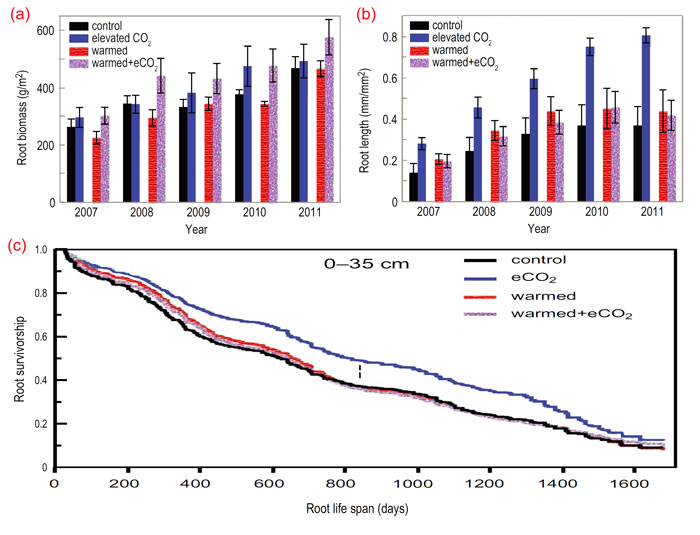| Tweet | Follow @co2science |
Paper Reviewed
Mueller, K.E., LeCain, D.R., McCormack, M.L., Pendall, E., Carlson, M. and Blumenthal, D.M. 2018. Root responses to elevated CO2, warming and irrigation in a semi-arid grassland: Integrating biomass, length and life span in a 5-year field experiment. Journal of Ecology 106: 2176-2189.
While much research has been conducted on the impact of elevated CO2 on the aboveground growth and biomass of plants, far less is known about such impacts belowground.
Seeking to provide some information on this topic, Mueller et al. (2018) assessed root biomass and length dynamics in a mixed-grass prairie ecosystem over a five-year period. The experiment location was west of Cheyenne, Wyoming, USA, in a plant community dominated by several C3 graminoid species (>45%) and a perennial C4 grass (15-40%), with smaller percentages of diverse forbs and subshrubs (5-35%). Treatments included (a) ambient CO2 (~400 ppm) and ambient temperature, (b) elevated CO2 (600 ppm during daylight hours only of the growing season) and ambient temperature, (c) ambient CO2 and elevated temperature (+1.5°C during the day and +3.0°C during the night) (d) elevated CO2 and elevated temperature. Elevated CO2 was supplied using a Free-air CO2 Enrichment (FACE) system and elevated temperatures were achieved using infrared heaters.
The results of the study revealed, as shown in the accompanying figure, that elevated CO2 had a positive impact on both root biomass and root length in the upper soil profile (0-15 cm), though the effect was much stronger for root length. Root survivorship (assessed over the full soil layer, 0-35 cm) was also enhanced by elevated CO2. Warming had less of an influence on root biomass and survivorship, but positively influenced root length. And in the combined elevated CO2 and elevated temperature treatment, root biomass and root length were both enhanced, whereas root survivorship remained mostly unchanged from the control treatment.
In summarizing their findings, Mueller et al. say that the stimulation of total root length and root life span under elevated CO2 alone and in combination with warming likely enhanced plant access to needed resources, such as water and phosphorus. Such root responses, in their words, "help explain previous observations of higher, and more stable, above-ground productivity in these projected climate conditions." And thus the future looks bright for this mixed-grass prairie ecosystem under elevated CO2, elevated temperature or elevated CO2 and elevated temperature.

Figure 1. Measurements of root biomass (Panel a) and root length (Panel b) for the 0-15 cm depth profile of the soil. Each column shows the treatment mean and the error bars show standard error. Panel c: Kaplan-Meier survivorship curves for roots produced in years 2007-2009 and each treatment over the full 0-35 cm depth of soil measurements. Source: Mueller et al. (2018).




